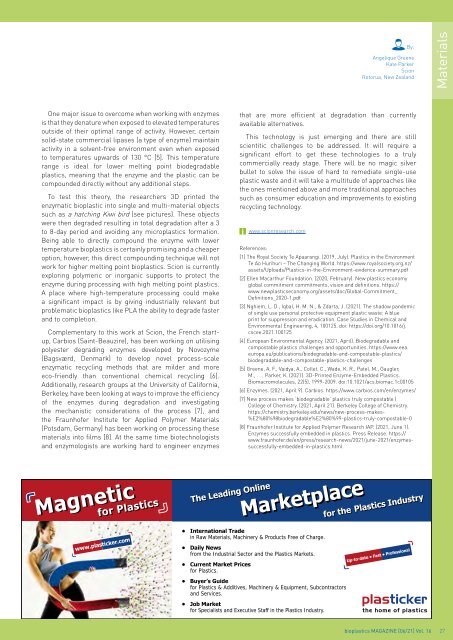Issue 06/2021
Highlights: Coating Films, Flexibles, Bags Basics: Cellulose based bioplastics
Highlights:
Coating
Films, Flexibles, Bags
Basics: Cellulose based bioplastics
Create successful ePaper yourself
Turn your PDF publications into a flip-book with our unique Google optimized e-Paper software.
By:<br />
Angelique Greene<br />
Kate Parker<br />
Scion<br />
Rotorua, New Zealand<br />
Materials<br />
One major issue to overcome when working with enzymes<br />
is that they denature when exposed to elevated temperatures<br />
outside of their optimal range of activity. However, certain<br />
solid-state commercial lipases (a type of enzyme) maintain<br />
activity in a solvent-free environment even when exposed<br />
to temperatures upwards of 130 °C [5]. This temperature<br />
range is ideal for lower melting point biodegradable<br />
plastics, meaning that the enzyme and the plastic can be<br />
compounded directly without any additional steps.<br />
To test this theory, the researchers 3D printed the<br />
enzymatic bioplastic into single and multi-material objects<br />
such as a hatching Kiwi bird (see pictures). These objects<br />
were then degraded resulting in total degradation after a 3<br />
to 8-day period and avoiding any microplastics formation.<br />
Being able to directly compound the enzyme with lower<br />
temperature bioplastics is certainly promising and a cheaper<br />
option, however, this direct compounding technique will not<br />
work for higher melting point bioplastics. Scion is currently<br />
exploring polymeric or inorganic supports to protect the<br />
enzyme during processing with high melting point plastics.<br />
A place where high-temperature processing could make<br />
a significant impact is by giving industrially relevant but<br />
problematic bioplastics like PLA the ability to degrade faster<br />
and to completion.<br />
Complementary to this work at Scion, the French startup,<br />
Carbios (Saint-Beauzire), has been working on utilising<br />
polyester degrading enzymes developed by Novozyme<br />
(Bagsværd, Denmark) to develop novel process-scale<br />
enzymatic recycling methods that are milder and more<br />
eco-friendly than conventional chemical recycling [6].<br />
Additionally, research groups at the University of California,<br />
Berkeley, have been looking at ways to improve the efficiency<br />
of the enzymes during degradation and investigating<br />
the mechanistic considerations of the process [7], and<br />
the Fraunhofer Institute for Applied Polymer Materials<br />
(Potsdam, Germany) has been working on processing these<br />
materials into films [8]. At the same time biotechnologists<br />
and enzymologists are working hard to engineer enzymes<br />
that are more efficient at degradation than currently<br />
available alternatives.<br />
This technology is just emerging and there are still<br />
scientitic challenges to be addressed. It will require a<br />
significant effort to get these technologies to a truly<br />
commercially ready stage. There will be no magic silver<br />
bullet to solve the issue of hard to remediate single-use<br />
plastic waste and it will take a multitude of approaches like<br />
the ones mentioned above and more traditional approaches<br />
such as consumer education and improvements to existing<br />
recycling technology.<br />
www.scionresearch.com<br />
References:<br />
[1] The Royal Society Te Apaarangi. (2019, July). Plastics in the Environment<br />
Te Ao Hurihuri – The Changing World. https://www.royalsociety.org.nz/<br />
assets/Uploads/Plastics-in-the-Environment-evidence-summary.pdf<br />
[2] Ellen Macarthur Foundation. (2020, February). New plastics economy<br />
global commitment commitments, vision and definitions. https://<br />
www.newplasticseconomy.org/assets/doc/Global-Commitment_<br />
Definitions_2020-1.pdf<br />
[3] Nghiem, L. D., Iqbal, H. M. N., & Zdarta, J. (<strong>2021</strong>). The shadow pandemic<br />
of single use personal protective equipment plastic waste: A blue<br />
print for suppression and eradication. Case Studies in Chemical and<br />
Environmental Engineering, 4, 100125. doi: https://doi.org/10.1016/j.<br />
cscee.<strong>2021</strong>.100125<br />
[4] European Environmental Agency. (<strong>2021</strong>, April). Biodegradable and<br />
compostable plastics challenges and opportunities. https://www.eea.<br />
europa.eu/publications/biodegradable-and-compostable-plastics/<br />
biodegradable-and-compostable-plastics-challenges<br />
[5] Greene, A. F., Vaidya, A., Collet, C., Wade, K. R., Patel, M., Gaugler,<br />
M., . . . Parker, K. (<strong>2021</strong>). 3D-Printed Enzyme-Embedded Plastics.<br />
Biomacromolecules, 22(5), 1999-2009. doi:10.1021/acs.biomac.1c00105<br />
[6] Enzymes. (<strong>2021</strong>, April 9). Carbios. https://www.carbios.com/en/enzymes/<br />
[7] New process makes ‘biodegradable’ plastics truly compostable |<br />
College of Chemistry. (<strong>2021</strong>, April 21). Berkeley College of Chemistry.<br />
https://chemistry.berkeley.edu/news/new-process-makes-<br />
%E2%80%98biodegradable%E2%80%99-plastics-truly-compostable-0<br />
[8] Fraunhofer Institute for Applied Polymer Research IAP. (<strong>2021</strong>, June 1).<br />
Enzymes successfully embedded in plastics. Press Release. https://<br />
www.fraunhofer.de/en/press/research-news/<strong>2021</strong>/june-<strong>2021</strong>/enzymessuccessfully-embedded-in-plastics.html<br />
Magnetic<br />
for Plastics<br />
www.plasticker.com<br />
• International Trade<br />
in Raw Materials, Machinery & Products Free of Charge.<br />
• Daily News<br />
from the Industrial Sector and the Plastics Markets.<br />
• Current Market Prices<br />
for Plastics.<br />
• Buyer’s Guide<br />
for Plastics & Additives, Machinery & Equipment, Subcontractors<br />
and Services.<br />
• Job Market<br />
for Specialists and Executive Staff in the Plastics Industry.<br />
Up-to-date • Fast • Professional<br />
bioplastics MAGAZINE [<strong>06</strong>/21] Vol. 16 27

















